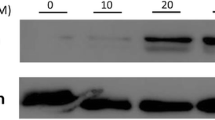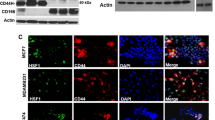Abstract
Purpose
Among the family of heat shock proteins (HSPs), HSP70 and HSP27 have been implicated in tumorigenesis and chemoresistance, probably via the prevention of apoptosis. HSP27 levels are frequently increased in large populations of tumors of the head and neck, but the mechanism of its chemoresistance is not yet fully understood. In the present study, the role of HSP27 in the resistance to cytotoxic stress was studied in Hep-2 human laryngeal cancer cells.
Method
We established a Hep-2 cell line overexpressing HSP27 and examined whether the expression of HSP27 provides resistance to heat shock and several cytotoxic agents using a MTT colorimetic assay. Cell cycle progression was assessed by flow cytometry and fluorescence staining was performed for F-actin filaments.
Results
HSP27 overexpression induced cellular resistance to heat shock at 45°C for 1 h as well as against several cytotoxic agents, including cisplatin, staurosporin and H2O2. However, no difference in sensitivity to irradiation or serum starvation was found. Moreover, HSP27 overexpressing Hep-2 cells showed a delayed cell growth, compared to control cells. To determine if the decreased cell proliferation in HSP27 overexpressing cells contributed to chemoresistance, control Hep-2 cells were synchronized at the late G1 phase by treatment with mimosine. The synchronized Hep-2 cells were resistant to cisplatin and H2O2, but not to irradiation or serum starvation, correlating the protection effect shown in HSP27 overexpressing cells. These results suggest that the overexpression of HSP27 in Hep-2 cells confers chemoresistance which is associated with the delay in cell growth. We also propose that the stabilization of F-actin observed in Hep-2/hsp27 cells is partly related to the delay in cell cycle progression, by showing that the induction of actin polymerization in Hep-2/neo cells results in the retardation of cell growth as well as a cytoprotective effect as observed in Hep-2/hsp27.





Similar content being viewed by others
References
Bohmer RM, Scharf E, Assoian RK (1996) Cytoskeletal integrity is required throughout the mitogen stimulation phase of the cell cycle and mediates the anchorage-dependent expression of cyclin D1. Mol Biol Cell 7:101–111
Bruey JM, Ducasse C, Bonniaud P, Ravagnan L, Susin SA, Diaz-Latoud C, Gurbuxani S, Arrigo AP, Kroemer G, Solary E, Garrido C (2000) Hsp27 negatively regulates cell death by interacting with cytochrome c. Nat Cell Biol 2(9):645–652
Bubb MR, Senderowicz AM, Sausville EA, Duncan KL, Korn ED (1994) Jasplakinolide, a cytotoxic natural product, induces actin polymerization and competitively inhibits the binding of phalloidin to F-actin. J Biol Chem 269(21):14869–14871
Butt E, Immler D, Meyer HE, Kotlyarov A, Laass K, Gaestel M (2001) Heat shock protein 27 is a substrate of cGMP-dependent protein kinase in intact human platelets: phosphorylation-induced actin polymerization caused by HSP27 mutants. J Biol Chem 276:7108–7113
Chae YJ, Kim HS, Rhim H, Kim BE, Jeong SW, Kim IK (2001) Activation of caspase-8 in 3-deazaadenosine-induced apoptosis of U-937 cells occurs downstream of caspase-3 and caspase-9 without Fas receptor-ligand interaction. Exp Mol Med 33:284–292
Concannon CG, Orrenius S, Samali A (2001) Hsp27 inhibits cytochrome c-mediated caspase activation by sequestering both pro-caspase-3 and cytochrome c. Gene Expr 9:195–201
Fortin A, Raybaud-Diogene H, Tetu B, Deschenes R, Huot J, Landry J (2000) Overexpression of the 27 KDa heat shock protein is associated with thermoresistance and chemoresistance but not with radioresistance. Int J Radiat Oncol Biol Phys 46:1259–1266
Gandour-Edwards R, Trock BJ, Gumerlock P, Donald PJ (1998) Heat shock protein and p53 expression in head and neck squamous cell carcinoma. Otolaryngol Head Neck Surg 118:610–615
Hino M, Kurogi K, Okubo MA, Murata-Hori M, Hosoya H (2000) Small heat shock protein 27 (HSP27) associates with tubulin/microtubules in HeLa cells. Biochem Biophys Res Commun 271:164–169
Kubler MD, Jordan PW, O’Neill CH, Watt FM (1991) Changes in the abundance and distribution of actin and associated proteins during terminal differentiation of human epidermal keratinocytes. J Cell Sci 100(Pt 1):153–165
Launay S, Brown G, Machesky LM (2003) Expression of WASP and Scar1/WAVE1 actin-associated proteins is differentially modulated during differentiation of HL-60 cells. Cell Motil Cytoskeleton 54(4):274–285
Lavoie JN, Hickey E, Weber LA, Landry J (1993) Modulation of actin microfilament dynamics and fluid phase pinocytosis by phosphorylation of heat shock protein 27. J Biol Chem 268:24210–24214
Leon X, Quer M, Orus C, Lopez M, Gras JR, Vega M (2001) Results of salvage surgery for local or regional recurrence after larynx preservation with induction chemotherapy and radiotherapy. Head Neck 23:733–738
Leon X, Lopez-Pousa A, de Vega M, Orus C, de Juan M, Quer M (2005) Results of an organ preservation protocol with induction chemotherapy and radiotherapy in patients with locally advanced laryngeal carcinoma. Eur Arch Otorhinolaryngol 262:93–98
Lindquist S (1986) The heat-shock response. Annu Rev Biochem 55:1151–1191
Lindquist S, Craig EA (1988) The heat-shock proteins. Annu Rev Genet 22:631–777
Liu FF, Miller N, Levin W, Zanke B,Cooper B, Henry M, Sherar MD, Pintilie M, Hunt JW, Hill RP (1996) The potential role of HSP70 as an indicator of response to radiation and hyperthermia treatments for recurrent breast cancer. Int J Hyperthermia 12:197–208
Mairesse N, Bernaert D, Del Bino G, Horman S, Mosselmans R, Robaye B, Galand P (1998) Expression of HSP27 results in increased sensitivity to tumor necrosis factor, etoposide, and H2O2 in an oxidative stress-resistant cell line. J Cell Physiol 177:606–617
Mazurov VV, Solovieva ME, Leshchenko VV, Kruglov AG, Edelweiss EF, Yakubovskaya RI, Akatov VS (2003) Small heat shock protein hsp27 as a possible mediator of intercellular adhesion-induced drug resistance in human larynx carcinoma HEp-2 cells. Biosci Rep 23:187–197
McMillan JN, Sia RA, Lew DJ (1998) A morphogenesis checkpoint monitors the actin cytoskeleton in yeast. J Cell Biol 142(6):1487–1499
Nakopoulou L, Lazaris AC, Baltas D, Giannopoulou I, Kavantzas N, Tzonou A (1995) Prognostic evaluation of oestrogen-regulated protein immunoreactivity in ductal invasive (NOS) breast cancer. Virchows Arch 427:33–40
Niwa H, Yamamura K, Miyazaki J (1991) Efficient selection for high-expression transfectants with a novel eukaryotic vector. Gene 108:193–199
Orus C, Leon X, Vega M, Quer M (2000) Initial treatment of the early stages (I, II) of supraglottic squamous cell carcinoma: partial laryngectomy versus radiotherapy. Eur Arch Otorhinolaryngol 257:512–516
Parcellier A, Schmitt E, Brunet M, Hammann A, Solary E, Garrido C (2005) Small heat shock proteins HSP27 and alphaB-crystallin: cytoprotective and oncogenic functions. Antioxid Redox Signal 7:404–413
Paulus JA, Tucker RD, Flanagan SW, Moseley PL, Loening SA, Park JB (1993) Heat shock protein response in a prostate tumor model to interstitial thermotherapy: implications for clinical treatment. Prostate 23:263–270
Quintana FJ, Cohen IR (2005) Heat shock proteins as endogenous adjuvants in sterile and septic inflammation. J Immunol 175:2777–2782
Reshetnikova G, Barkan R, Popov B, Nikolsky N, Chang LS (2000) Disruption of the actin cytoskeleton leads to inhibition of mitogen-induced cyclin E expression, Cdk2 phosphorylation, and nuclear accumulation of the retinoblastoma protein-related p107 protein. Exp Cell Res 259:35–53
Richards EH, Hickey E, Weber L, Master JR (1996) Effect of overexpression of the small heat shock protein HSP27 on the heat and drug sensitivities of human testis tumor cells. Cancer Res 56:2446–2451
Sakamoto H, Mashima T, Yamamoto K, Tsuruo T (2002) Modulation of heat-shock protein 27 (Hsp27) anti-apoptotic activity by methylglyoxal modification. J Biol Chem 277(48):45770–45775
Schwartz JL (1989) monofunctional alkylating agent-induced S-phase-dependent DNA damage. Mutat Res 216(2):111–118
Searles CD, Ide L, Davis ME, Cai H, Weber M (2004) Actin cytoskeleton organization and posttranscriptional regulation of endothelial nitric oxide synthase during cell growth. Circ Res 95(5):488–495
Sugerman PB, Savage NW, Xu LJ, Walsh LJ, Seymour GJ (1995) Heat shock protein expression in oral epithelial dysplasia and squamous cell carcinoma. Eur J Cancer B Oral Oncol 31B:63–67
Trielli MO, Andreassen PR, Lacroix FB, Margolis RL (1996) Differential Taxol-dependent arrest of transformed and nontransformed cells in the G1 phase of the cell cycle, and specific-related mortality of transformed cells. J Cell Biol 135:689–700
Uozaki H, Horiuchi H, Ishida T, Iijima T, Imamura T, Machinami R (1997) Overexpression of resistance-related proteins (metallothioneins, glutathione-S-transferase pi, heat shock protein 27, and lung resistance-related protein) in osteosarcoma. Relationship with poor prognosis. Cancer 79:2336–2344
Vackova I, Engelova M, Marinov I, Tomanek M (2003) Cell cycle synchronization of porcine granulosa cells in G1 stage with mimosine. Anim Reprod Sci 77(3–4):235–245
Vargas-Roig LM, Gago FE, Tello O, Aznar JC, Ciocca DR (1998) Heat shock protein expression and drug resistance in breast cancer patients treated with induction chemotherapy. Int J Cancer 79:468–475
Walsh D, Grantham J, Zhu XO, Wei Lin J, van Oosterum M, Taylor R, Edwards M (1999) The role of heat shock proteins in mammalian differentiation and development. Environ Med 43:79–87
Wang K, Spector A (1996) Alpha-crystallin stabilizes actin filaments and prevents cytochalasin-induced depolymerization in a phosphorylation-dependent manner. Eur J Biochem 242:56–66
Wei L, Wang L, Carson JA, Agan JE, Imanaka-Yoshida K, Schwartz RJ (2001) Beta1 integrin and organized actin filaments facilitate cardiomyocyte-specific RhoA-dependent activation of the skeletal alpha-actin promoter. FASEB J 15(3):785–796
Welch WJ (1993) Heat shock proteins functioning as molecular chaperones: their roles in normal and stressed cells. Philos Trans R Soc Lond B Biol Sci 339:327–333
Acknowledgments
This work was supported, in part, by grants from the alumni associated of the Department of Otolaryngology Head and Neck Surgery, The Catholic University of Korea.
Author information
Authors and Affiliations
Corresponding author
Additional information
Jung-Hee Lee and Dongil Sun have contributed equally to this work.
Rights and permissions
About this article
Cite this article
Lee, JH., Sun, D., Cho, KJ. et al. Overexpression of human 27 kDa heat shock protein in laryngeal cancer cells confers chemoresistance associated with cell growth delay. J Cancer Res Clin Oncol 133, 37–46 (2007). https://doi.org/10.1007/s00432-006-0143-3
Received:
Accepted:
Published:
Issue Date:
DOI: https://doi.org/10.1007/s00432-006-0143-3




